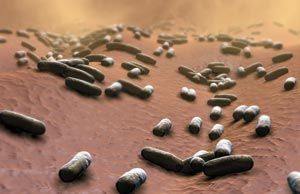New MS-Based Method “Fingerprints” Air to Diagnose Infection
A team of chemists and microbiologists from the University of Leicester has developed a new method of rapidly diagnosing the infection Clostridium difficile (C. difficile).
A team of chemists and microbiologists from the University of Leicester has developed a new method of rapidly diagnosing the infection Clostridium difficile (C. difficile).1 This bacterium causes diarrhoea and is a particular problem in hospitals, where immuneâcompromised patients are particularly susceptible to it. The bacterium is resilient and can live for weeks or longer on surfaces; thus, if it is not rapidly identified and contained, it can spread quickly.
Photo Credit: MedicalRF.com/Getty Images

The new method uses the fact that these microorganisms produce metabolic volatile organic compounds (VOCs) during growth and in other processes. By analyzing the headspace above a C. difficile sample, the organism can be identified. This test is carried out using proton transfer reactionâtime of flight-mass spectrometry (PTR–TOF–MS). In this technique, the additional proton in a hydronium ion has a higher affinity for the VOCs than it does for water, which results in the organic compound becoming charged, after which it can be detected in the mass spectrometer. The ionization technique, which uses H3O+, is relatively gentle, so most peaks in the mass spectrum are assumed to be from protonated molecular ions.
In essence, this method is “fingerprinting” air, by identifying and measuring the quantity of the volatile organic compounds present. Thus, the diarrhoea of a person suffering from C. difficile would give off different VOCs than a sample from an uninfected person. Standard immunoassay tests currently in use for C. difficile diagnosis under national guidelines in the UK usually take 24–48 h. However, this new test can take as little as 5 minutes. This test can also differentiate between strains of the bacteria (not all of which are pathogenic) because different types of C. difficile produce different mass spectra. This differentiation information is not provided by standard tests currently in use.
Professor Paul Monks, a professor of analytical chemistry at Leicester and who is a member of the research team at Leicester, said that further development is necessary before the method can be applied in a clinical setting. “It will require some time and investment before a cheap, simple, and practical sensor can be developed that will give a simple yes-no answer on a sample,” he said. “The good news is that this may only take a couple of years, a very short time in the context of clinical advances.”
The fundamental principle of this technique can also be applied to a wide range of areas, such as to track air pollution, or to test breath in order to determine the length of time since someone last had an alcoholic drink, or even to tell when mangoes are ripe. Over the next few years we could see a rise in the development of a variety of applications for this method of “fingerprinting air”.
Reference
- S. Kuppusami, M.R.J. Clokie, T. Panayi, A.M. Ellis, and P.S. Monks, Metabolomics11, 251–260 (2014).

New Study Reviews Chromatography Methods for Flavonoid Analysis
April 21st 2025Flavonoids are widely used metabolites that carry out various functions in different industries, such as food and cosmetics. Detecting, separating, and quantifying them in fruit species can be a complicated process.
Quantifying Terpenes in Hydrodistilled Cannabis sativa Essential Oil with GC-MS
April 21st 2025A recent study conducted at the University of Georgia, (Athens, Georgia) presented a validated method for quantifying 18 terpenes in Cannabis sativa essential oil, extracted via hydrodistillation. The method, utilizing gas chromatography–mass spectrometry (GC–MS) with selected ion monitoring (SIM), includes using internal standards (n-tridecane and octadecane) for accurate analysis, with key validation parameters—such as specificity, accuracy, precision, and detection limits—thoroughly assessed. LCGC International spoke to Noelle Joy of the University of Georgia, corresponding author of this paper discussing the method, about its creation and benefits it offers the analytical community.











